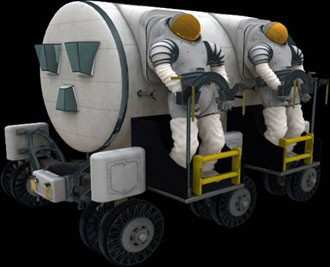They’re at the Post
NASA is soliciting proposals for a next-generation LTV (Lunar Terrain Vehicle) by which the agency’s astronauts will be better able to explore the lunar south pole during near-future Artemis missions.

By dint of a new generation of LTVs, Artemis astronauts will ostensibly explore and sample tracts of the lunar surface vastly beyond the pale of even the most able-bodied moonwalkers.
By eschewing the designing and building its own LTV and, instead, tasking its industry partners with the provision of such, NASA contemporaneously leverages commercial innovation; stretches tax-dollars; and achieves its human spaceflight, scientific, and exploratory objectives.
Lara Kearney, manager of NASA’s Extravehicular Activity and Human Surface Mobility program at the agency’s Johnson Space Center, stated: “We want to leverage industry’s knowledge and innovation, combined with NASA’s history of successfully operating rovers, to make the best possible surface rover for our astronaut crews and scientific researchers.”
When complete, NASA’s LTV will function after the fashion of an Apollo-style lunar rover hybridized with a Mars-style unmanned rover. The contraption will function both autonomously and under the control of astronaut drivers, thereby allowing NASA to remain about its mission of discovery even in instances too distant or dangerous for hands-on human exploration.
Artemis astronauts will use the LTV to traverse the lunar surface and transport scientific equipment too awkward, too heavy, or requiring conveyance over distances too great to be taken on the arches. Conversely, NASA engineers will be able to operate the LTV remotely for purpose of transporting cargo and scientific payloads between crewed landing sites—in so doing expanding lunar scientific research opportunities during uncrewed operations, allowing scientists to investigate future surface mission locations, and informing research goals and objectives for each crewed site.
To function in the unique environments in the vicinity of the lunar South Pole—which include permanently-shadowed regions and extended sunless periods—the LTV will comprise mission-critical systems the likes of advanced power management, semi-autonomous driving, state-of-the-art communication and navigation systems, and protection from the moon’s environmental extremes.

As part of their respective proposals, companies are required to provide end-to-end services—from the development of LTV vehicles and the delivery of such to the lunar surface to execution of autonomous and manned operations. Each rover concept must be able to carry two suited astronauts, accommodate a robotic arm or similar mechanism germane to scientific exploration, and survive the extreme hot and cold temperatures characteristic of the lunar South Pole. Companies submitting LTV proposals will be required to autonomously demonstrate the functionality of their platforms in the lunar environment prior to the machines being entrusted with the lives of NASA astronauts.
The first lunar use of the LTV currently being solicited will likely occur during NASA’s planned 2029 Artemis V mission.
Proposals for the LTV services contract must be remitted to NASA by 10 July 2023. The contract’s award is scheduled for November 2023.
 ANN's Daily Aero-Linx (05.06.25)
ANN's Daily Aero-Linx (05.06.25) ANN's Daily Aero-Term (05.06.25): Ultrahigh Frequency (UHF)
ANN's Daily Aero-Term (05.06.25): Ultrahigh Frequency (UHF) ANN FAQ: Q&A 101
ANN FAQ: Q&A 101 Classic Aero-TV: Virtual Reality Painting--PPG Leverages Technology for Training
Classic Aero-TV: Virtual Reality Painting--PPG Leverages Technology for Training Airborne 05.02.25: Joby Crewed Milestone, Diamond Club, Canadian Pilot Insurance
Airborne 05.02.25: Joby Crewed Milestone, Diamond Club, Canadian Pilot Insurance




